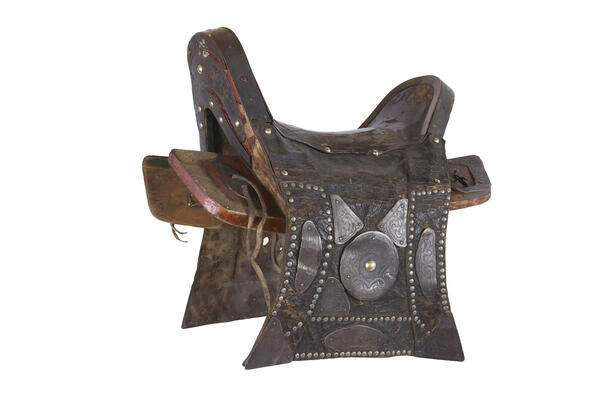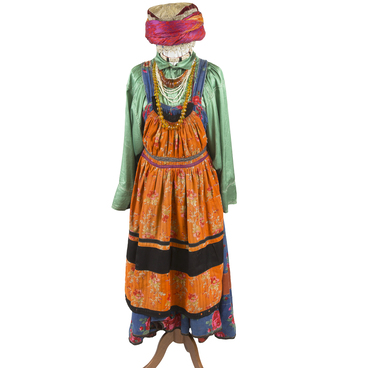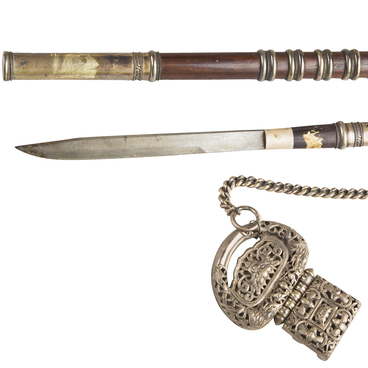A traditional Buryat saddle used for horseback riding is displayed in the Regional Museum of Local Lore. The item has a wooden base with bent front and rear edges — the pommel and cantle. The protruding parts are decorated with black plates.
The back is bent at a 45-degree angle. This allowed the rider to lean back comfortably, but still keep his balance. For example, when the rider was performing a military maneuver, he could turn back and, while shooting a bow, he would not fall out of the saddle.
The cushion on the top of the base was fixed and covered with black leather. The side “tebenki” (flaps) — the long dangling edges of the seat — protected the rider’s legs from friction with the stirrup strap. They were decorated with round metal plates with plant-based ornaments and rivets.
Some Buryat tribes were nomadic herders. In summer, they herded their cattle to pastures in the taiga, and in winter — to river valleys and steppes. The horse was a means of transportation for the Buryats, an assistant for household chores and hunting.
The animal was so important to the residents of the Transbaikal area that a horse cult was formed in the region. The Buryats believed that the horse could see beings from the other world. If the animal stopped abruptly in the middle of the path, the stallion could not be punished. It was believed that he saw a spirit on the road and let it pass by.
Furthermore, it was believed that the animal always reunites with its master in the afterlife. That is why the Buryats were buried together with the horse they rode. Most often, the stallion was sacrificed at the master’s grave, skinned and hung on a pole nearby.
The ritual varied from tribe to tribe, but its significance was the same in all regions — the horse helped the deceased to cross over to the other world, to the spirits, and to meet his ancestors. It was believed that without a horse the nomads would get lost.
The horse was a helper of the Buryats, so it was treated with reverence. The saddle and harness were adorned with various decorative elements made of leather, beads and silver. There was a popular saying:
The back is bent at a 45-degree angle. This allowed the rider to lean back comfortably, but still keep his balance. For example, when the rider was performing a military maneuver, he could turn back and, while shooting a bow, he would not fall out of the saddle.
The cushion on the top of the base was fixed and covered with black leather. The side “tebenki” (flaps) — the long dangling edges of the seat — protected the rider’s legs from friction with the stirrup strap. They were decorated with round metal plates with plant-based ornaments and rivets.
Some Buryat tribes were nomadic herders. In summer, they herded their cattle to pastures in the taiga, and in winter — to river valleys and steppes. The horse was a means of transportation for the Buryats, an assistant for household chores and hunting.
The animal was so important to the residents of the Transbaikal area that a horse cult was formed in the region. The Buryats believed that the horse could see beings from the other world. If the animal stopped abruptly in the middle of the path, the stallion could not be punished. It was believed that he saw a spirit on the road and let it pass by.
Furthermore, it was believed that the animal always reunites with its master in the afterlife. That is why the Buryats were buried together with the horse they rode. Most often, the stallion was sacrificed at the master’s grave, skinned and hung on a pole nearby.
The ritual varied from tribe to tribe, but its significance was the same in all regions — the horse helped the deceased to cross over to the other world, to the spirits, and to meet his ancestors. It was believed that without a horse the nomads would get lost.
The horse was a helper of the Buryats, so it was treated with reverence. The saddle and harness were adorned with various decorative elements made of leather, beads and silver. There was a popular saying:



